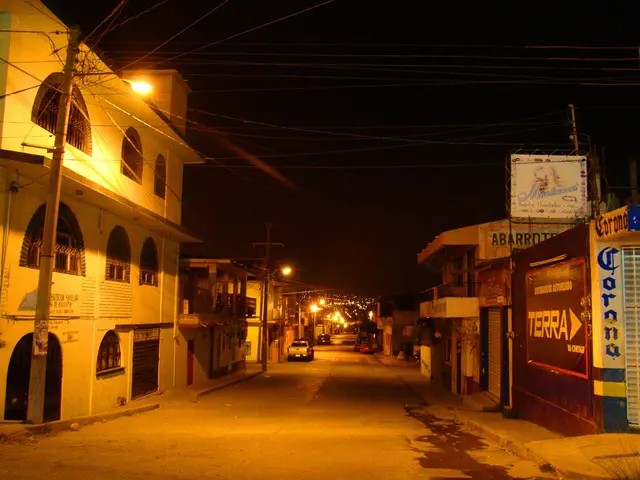Taking on the Aue River Challenge: Can AI be the Solution to Water Pollution?
- *
Can Artificial Intelligence Clean Up Polluted Bodies of Water? - Can Artificial Intelligence Clean Up Contaminated Waterways?
In the heart of the Cuxhaven district, a passionate team of conservationists, scientists, and locals is taking on a daunting mission: reviving the heavily polluted Aue River. They've devised an affordable, state-of-the-art water monitoring tool known as "Nala 1," which can function as an early warning system. This innovative device transmits real-time data on factors like temperature, oxygen content, and pH levels, measuring a 20-kilometer stretch of the Aue, a tributary of the Oste [1].
Tech Geeks to the Rescue
Not just a mere monitoring tool, Nala 1's artificial intelligence (AI) capabilities can analyze the gathered data and offer practical recommendations. The goal is to use AI to optimize the weir and lock systems, which regulate water volume and improve quality. Plus, AI could help identify the primary sources of pollution [1]. In the distant future, AI might even have the power to control locks and weirs autonomously. The project has gathered support from both the local municipality and maintenance association, demonstrating the growing interest in open-source environmental technology [1].
The Aue: Germany's Problem River
The Aue is infamous for its poor water quality, largely due to agricultural runoff. Sadly, low oxygen levels often lead to mass fish deaths. Elke Freimuth, one of the project's organizers, calls the Aue "a real problem child." This unfortunate reality echoes other German rivers, where only 8% were in good or excellent ecological condition in 2021, as per the Federal Environment Agency [1].
Local Initiatives for Community-Wide Impact
Fed up with idly watching the Aue's deterioration, the locals rallied experts like water expert Julia Steiwer from the University of Bremen to join their cause. Remarkably, the probe costs significantly less than commercial multisensor systems, making it more accessible for researchers, conservation groups, and private individuals to afford, gather data, analyze it, and implement solutions [1]. Additionally, it opens up the possibility for affordable data collection in other rivers across the country.
- Water Quality
- Cuxhaven district
- AI
- Rivers
- Oste
Enrichment Data:
While specific AI-powered water probes like 'Nala 1' aren't found in the research results, the broader implementation of AI technology presents opportunities for tackling water quality challenges in areas like the Cuxhaven district of Germany.
AI's Role in Water Quality Challenges
AI is revolutionizing water management by predicting and addressing water quality issues more effectively. It can:
- Data Analysis: AI can integrate real-time sensor data with existing datasets, forecasting changes in water quality indicators such as turbidity and nutrient levels [1][2].
- Proactive Maintenance: AI tools can foresee when water treatment equipment may fail or when water quality problems may arise. This allows for preventive measures to be taken, minimizing pollution events [4][5].
- Treatment Process Optimization: AI can fine-tune chemical dosages and other parameters in real-time to maintain optimal water quality, reducing waste and cutting operational costs [5].
- Anomaly Detection: AI can spot unusual water quality metrics or pinpoint leaks in water infrastructure, enabling prompt responses to mitigate pollution [5].
The Future of 'Nala 1' and Similar Probes
Incorporating AI technologies into water probes like 'Nala 1' could elevate monitoring and management efforts. Here's how:
- Enhanced Real-time Monitoring: AI-powered probes can offer real-time data on water quality parameters, helping to address pollution issues as they occur.
- Location-Specific Predictions: Utilizing sensor data and environmental conditions, AI can detect pollution spikes in specific areas, allowing for targeted management strategies.
- Integration with Existing Infrastructure: If 'Nala 1' can be merged with existing water management systems, it could significantly improve the accuracy and efficiency of their functions.
Though there's no mention of 'Nala 1' in the provided search results, the extensive use of AI in water quality management presents promising opportunities for improving river health across regions like Cuxhaven, Germany.
- The Project in Cuxhaven district aims to utilize the AI capabilities of Nala 1 to optimize weir and lock systems, improving water quality and identifying primary sources of pollution in the Aue River, a tributary of the Oste.
- AI can analyze real-time data gathered by Nala 1, offering practical recommendations for water management, such as optimizing chemical dosages to maintain optimal water quality and cutting operational costs.
- With the AI-powered Nala 1, water quality in the Aue River could be monitored more effectively, potentially allowing for targeted management strategies and improved river health across regions like Cuxhaven, Germany.







